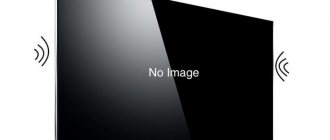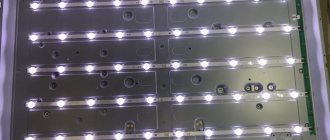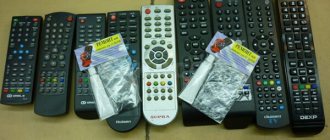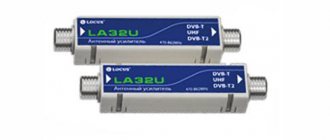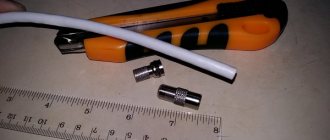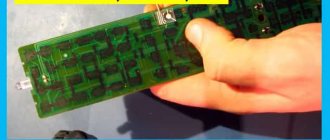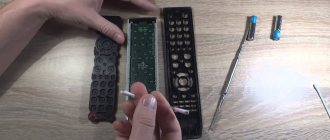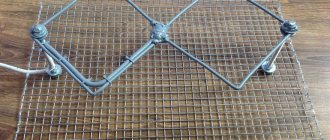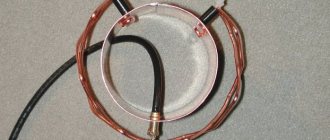Owners of television receivers with LCD screens are sometimes faced with a situation where it is necessary to replace the matrix on the TV. This raises the question: isn’t it easier to buy a new device, since the cost of replacing the LCD panel in service centers is very high? And if we add the price of a new screen, it turns out that the repair will cost almost the same as a new TV set. But in fact, not everything is so sad. Replacing a TV matrix is not such an impossible task. If you know the procedure, then this procedure can be performed by any home craftsman who knows how to hold a screwdriver in his hands.
What is an LCD matrix
This is the main element of TV technology responsible for image formation. The matrix is a flat container where a layer of liquid crystals is deposited between two plates. The latter, when voltage is applied, change the intensity of the glow.
Each individual crystal, also known as a pixel, carries three colors - blue, red and green. Light, passing through a specific tone, forms the final picture. That is, here we have a kind of set of mini-projectors.
Types of matrices
On the market you can find TVs with different types of matrices, but it is customary to take devices built using TN and IPS technology as a basis. And everything else (PLS, VA, etc.) are derivatives.
TN (TN + film)
The crystals here are arranged horizontally and are at a slight angle to each other, forming a spiral. Devices with a TN matrix have good response speed and low cost. A significant drawback of this technology is its modest viewing angles.
IPS
In this case, the crystals are aligned parallel to each other. IPS TVs offer maximum viewing angles while maintaining image quality. But due to the specifics of the technology, the response speed is noticeably increased. The cost of IPS matrices is noticeably higher than TN.
Signs of matrix failure
Liquid crystal technology, in addition to obvious advantages, has one significant drawback - frequent matrix breakdowns. Repair in specialized centers is an expensive procedure, but on modern devices it can be replaced at home.
Liquid crystal technology is picky about almost everything. The matrix can fail due to physical impact, contact with moisture or even dust. Improper use of the device also leads to dire consequences.
Visual effects indicating matrix failure:
- spots on the monitor of varying intensity;
- vertical or horizontal stripes;
- artifacts such as "snow";
- chaotic colored pixels;
- flashing picture.
If one of the above effects is detected, you should immediately begin to solve the problem, otherwise the matrix may completely fail, pulling other important elements with it. Let's take a closer look at the most common defects.
Mechanical impact
If the TV is dropped or hit, the matrix will immediately let you know about this with a broken image. Some budget models even react to soft objects or finger pressure. It is quite easy to identify such a defect by microcracks on the screen, broken glass or chips on the case. In addition to impacts, the cause of breakage can be kinks of the screen, for example, during transportation.
Picture distortion
A variety of effects can occur here. Some problems disappear on their own when, for example, the equipment warms up, while others remain.
The matrix requires repair in the following cases:
- frame slowdown;
- the appearance of thin vertical stripes;
- screen flickering in dynamic scenes;
- wide multi-colored stripes.
Important! Similar problems may appear if the control chip fails.
Stains
The source of the problem can be determined by the appearance of the spots. If the area is light, then this indicates broken glass or matrix delamination. Large dark areas indicate bending or moisture ingress into the device. Small black dots are damaged pixels. The latter cannot be repaired.
Causes and symptoms of malfunction
It's no secret that the matrix of a TV is its key part, but also perhaps the most vulnerable to damage. Often the glass surface is broken by children, it comes into contact with liquid, encounters mechanical shocks and many other influences. And if uncharacteristic spots, stripes and other graphic artifacts appear on the display, most likely the matrix will have to be replaced. Such a part is not cheap, and its installation service requires serious investment.
In this regard, experts advise taking proper care of the screen, servicing it and wiping it on time. If you need to move your TV to a new location, you should make sure that it is secure. Any shocks or falls can lead to loss of high-quality images, and then to the need to replace the matrix. Key signs of serious damage include :
- Vertical stripes appear along the screen.
- The appearance of thin horizontal stripes, drips and stains.
- Black circles appear on the monitor.
- The appearance of dark and light spots that do not disappear anywhere.
- Complete loss of image.
When the matrix interacts with a liquid, there is a chance to restore it without purchasing a new part. But the success of solving the problem depends on timely measures and skills taken. If the damage is mechanical in nature, you cannot do without replacing the element.
In most cases, matrix replacement is started due to careless handling of the TV and non-compliance with basic operating rules. The complexity of the repair is determined by the extent and cause of the breakdown. After all, if liquid gets on the screen, then restoration may take a long period of time, and it will not be possible to complete it with your own efforts. In this case, you will have to entrust the task to a trained professional.
In case of mechanical damage, there is a chance to “cure” the TV yourself. All you have to do is find a suitable part and install it following step-by-step instructions.
Replacing the matrix
Replacing the matrix on a Sony TV differs slightly from the procedure for replacing the screen (matrix) on an LG TV. Mainly, the difference lies in the design of the TV, which affects the procedure for disassembling it. Fastenings can be implemented in a standard way - with screws, or in a less convenient way - with latches, which are more difficult to detect and easy to break. Disassembly of the unit can be accessed from the front or rear.
Front access
With frontal access, disassembling the device should begin by releasing the latches that hold the panel lining.
There are models of LCD devices, including plasma ones, that have protective glass in front of the matrix. If the screen is broken, the protective glass will also have to be replaced.
Once the latches are released, you will see the LCD TV matrix attached to the TV body with screws that need to be removed. Please note that some screws may be doubled with a latch. After this, unscrew all the fasteners on the back wall of the device, which covers the entire electronic content of the device.
Rear access
To replace the matrix in an LG, Samsung or any other TV, including a plasma one, you will need to unscrew all the fasteners holding the back panel of the unit and remove the stand if it is a desktop model of the device. Since screws of different lengths may be screwed into different places on the back cover, you need to remember their location.
There are designs of television receivers in which a special hatch is provided on the back wall (for example, on an LG TV) for service maintenance during the warranty period. When removing the cover, you need to be careful not to damage the cables going to it. Also disconnect any modules that may be on the cover from the board. Replacing the screen is carried out in a similar way for a plasma TV.
Next, follow these steps.
- When the cover is removed, you will see in front of you the metal housing of the LCD TV matrix, on which all the electronic boards of the device and the cables connected to them are attached. You will need to be careful when disconnecting the cables (they cannot be loosened in different directions, but must be pulled, carefully, in a straight line). Disconnect them from all boards and modules of the unit. In order not to get confused about how to connect them back, you can take a photograph of their location before dismantling the LG TV matrix.
- Also disconnect all cables around the perimeter of the device. In some models they may be hidden under the frame surrounding the LCD panel. Attention: there are cables that can be pulled out only by lifting the bar holding them down.
- Next, you need to take a new unpacked matrix and put it next to it (with something soft underneath) with the faulty one. This is done for more convenient transfer of parts.
- The next step will be to one by one transfer all boards and modules from one case to another. As soon as the board is transferred, immediately connect all the cables coming from the screen to it.
- When all the modules are connected, you can install the cover and framing frame (if any) in place, close the back panel, thereby completing the assembly of the LCD TV receiver, and then check the operation of the device.
In order for the TV to start working correctly, you will need to coordinate the new matrix with all modules. To do this, you need to turn on the device, enter the service menu, and make settings.
How this is done is indicated in the instructions for the unit.
Advantages of contacting the official LG service center in Moscow
Our company has been restoring electronics for more than 12 years. The website has a section with customer reviews. Cooperation with official representatives of LGI (centralized procurement) allows our craftsmen to use original spare parts.
Features of service maintenance for LCD and plasma TVs LG:
- free shipping;
- modern equipment;
- reasonable prices;
- urgent repairs;
- 6 month warranty.
All equipment is officially repaired by LG workshop employees, which is why our company provides warranty service for at least six months. To replace the matrix or TV backlight, leave a request by phone or on the website - experienced engineers will eliminate any defect as soon as possible.
Expert advice
To correctly identify the causes of a breakdown, you should first eliminate problems with peripheral and internal equipment: check the cable, set-top box, video accelerator and color block.
The backlight may fail due to power surges. If necessary, it is easily replaced. If the repair exceeds the cost of a new matrix, then it makes sense to simply replace it.
Advice! It would also be a good idea to check the warranty periods. If they do not work, then the device with problems of any type must be taken to a service center.
Replacing the screen on an LCD or LED TV is not a difficult task, but it requires extreme care, since you can damage not only the very thin cables on the new matrix, but also the matrix itself, since it is very sensitive to kinks. Some other TV malfunctions can also be repaired yourself.
Preparation of the workplace
After a new matrix and protective screen have been purchased, you can proceed to preparing the workplace for the upcoming repair. It includes the following preparatory operations:
— first of all, you will need to lay a soft cloth or a sheet of not too hard cardboard on the desktop (this will eliminate the possibility of small scratches appearing on the LCD screen);
- then you will need to prepare the necessary set of hand tools (a set of screwdrivers with attachments and tweezers);
- and finally, you will need to stock up on a thin metal plate.
After all this is ready, you can proceed directly to replacing the television matrix.
